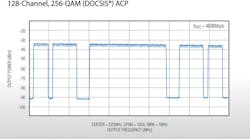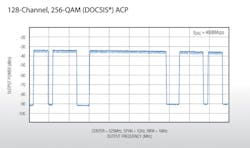Two Chips Synthesize Up To 128 QAM Channels For Cable TV Systems
You used to need a couple racks of modulator modules and related gear to accumulate and combine a full complement of TV channel signals that were ready to transmit. Now, you can do most of that with a couple of ICs. Maxim Integrated’s MAX5880 and MAX5882 chip set lets you assemble 128 channels of quadrature-amplitude modulated video ready for transmission.
The MAX5880 is a high-density downstream cable quadrature-amplitude modulator and digital upconverter (DUC). It is an ASIC that accepts source data in the form of forward-error-corrected encoded symbols from an FPGA, performs pulse shaping, and resamples each quadrature amplitude modulation (QAM) channel. Next, it combines, interpolates, and modulates up to 128 QAM channels that will be converted to an analog signal by an RF digital-to-analog converter (DAC).
The chip generates up to 128 QAM channels in steps of eight channels. The step size is field programmable. Individual channel bandwidths can range from 1 MHz to 8 MHz. The input digital symbol rate is from 1 Msymbol/s to 7.14 Msymbols/s and can be independently set for each channel. An integrated QAM mapper can produce 16/32/64/128/256 QAM. There are four 14-bit low-voltage differential signaling (LVDS) output ports to feed the external DACs. The device complies with CableLabs DOCSIS 3.0 DRFI. With the full 128 QAM channel complement, it consumes 3.3 W at 1.8 V and 4608 Msamples/s.
The MAX5880 is designed to interface directly with the MAX5882. This 14-bit, 4.6-Gsample/s RF DAC accepts the four multiplexed LVDS inputs from the MAX5880 DUC. The output is the full direct RF synthesis of the spectrum from 47 MHz to 1003 MHz. The output is a 50-Ω differential termination with a continuous power of 9 dBm (see the figure).
This spectrum analyzer output display shows the 128 QAM channels output generated by the MAX5882 and MAX5880 combination. The full bandwidth is 1 GHz with a center frequency of 525 MHz. The resolution bandwidth is 1 MHz. You can just make out the 6-MHz channels, 16 per 100-MHz segment.
This highly integrated and scalable chip combination replaces multiple QAM boxes needed to deliver broadcast TV, high-speed data, and Voice over Internet Protocol (VoIP) triple-play services as well as video on demand, switched digital video, and interactive Internet Protocol television (IPTV). It gives cable service providers the bandwidth to handle future cable services while reducing capital and operational expenditures.
The MAX3518 DOCSIS 3.0 cable return amplifier is used to drive the coax that sends high-speed data back to the cable head-end cable modem termination system (RX). When the cable modem box talks back to the cable company or when you send data files from your PC over the cable network, the MAX3518 drives the coax from the home modem back to the nearest return node, where it is then transported back to the cable plant. It operates in the 5- to 85-MHz return path cable spectrum. The high linearity, broadband amplifier also can deliver more than 64-dBmV output (75 Ω).
The MAX5880 and MAX5882 each come in a 17- by 17-mm, 256-pin chip-scale ball-grid array (CSBGA) package. An evaluation kit is available.
Maxim Integrated


